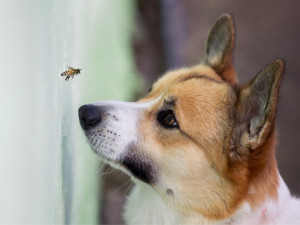Giant Flying Spiders Are Coming to the East Coast—Can They Be Harmful to Pets?
Holy Stranger Things! (But calm down; it’s not nearly that bad.)
By now, you’ve probably seen the headlines: A super large, venomous neon spider is going to invade the Northeastopens in new tab — oh, and it also flies. It’s not exactly info you don’t share with everyone in your social circle. After a year of orange skies, total solar eclipses, and historical cicada emergences, the news sounds more than a little apocalyptic.
The freaky arachnids are called Joro spiders, named after a Japanese spider demon, and they’re native to China, Japan, Korea, and Taiwanopens in new tab. They’ve been in Georgia for over a decade, with some sightings throughout the South. Now, scientists have found that it’s likely the spiders will continue expanding north, because they can thrive in the Northeast’s environmental conditions. They aren’t sure exactly when the spiders will make their appearance on the East Coast.
If you’re a Northeastern pet parent, you’re probably wondering if the spiders are harmful to your dog or cat — they’re “venomous,” after all. But we have good news: They are not dangerous. Your pets are safe. You’re safe, too. Everyone can take some deep breaths, because the Joro spiders are way less scary than you might expect.
Don’t stress: The spiders are harmless
Look, no one likes giant venomous flying spiders. But as far as giant venomous flying spiders go, Joro spiders are nothing to worry about. Pretty much every component of the spider’s reputation (“giant,” “venomous,” and “flying”) comes with a few caveats.
How much do you spend on your pet per year?
They’re large, but most reports of their size are exaggeratedopens in new tab — they don’t really look “palm sized,” as some publications are saying, without their legs impossibly stretched out. They don’t technically fly, either — as in, they don’t have wings. Instead, they “balloon,” soaring through the air on their silks. It’s only the spiderlings who do this, too; the giant version of the spider won’t be whizzing by you in midair. Small comforts.
But most importantly, their venom isn’t an issue for people or pets. Most spiders are venomous — it’s just that the venom is reserved for the smaller insects they’re eating. “They’re not out flying around and hunting for people; there’s no evidence they’re dangerous to people or pets,” David Coyle,opens in new tab an assistant professor and invasive species expert at Clemson University, told NBC 24.
A Joro spider’s bite is reported to feel like anything from a mosquito bite to a bee sting (in many cases, a bite won’t pierce the skin at all), which could be uncomfortable for a pet — but the venom won’t seriously harm them.
It’s possible that a pet could be allergic to a Joro bite — though, rest assured, no instances of allergic reactionsopens in new tab in animals or humans have been reported yet. Any time your pet is bitten by an insect, keep an eye out for allergy symptoms like redness around the bite, hives, and trouble breathing.
They’re also super shy
Andrew Davisopens in new tab, a scientist at the University of Georgia, conducted an experimentopens in new tab on Joro spiders that proved that they’re actually pretty antisocial, nervous creatures. When native spiders experienced a puff of air, they froze for 96 seconds; the Joro spiders froze for over an hour. “Based on my research, they’re really shy,” Davis told National Geographic. “If you leave them alone, they’ll leave you alone, and you can both go about your business.”
Coyle told National Geographic that the Joro’s spider temperament is far from aggressive. “I have held Joro spiders dozens of times,” he said. “My kids have held them. They’re typically very docile.”
In other words, they definitely won’t seek out a fight with your pet. “If [a dog] went and put his snout through the web, it might land on him and feel threatened and bite him, but it would be the same as if a human did that,” Gail Reynoldsopens in new tab, master gardener coordinator at the University of Connecticut Extension, told Connecticut Public.
Because the spiders are an invasive species, the scariest thing about them is their potential impact on the local environment. At the same time, the spiders eat other invasive species, including the notorious spotted lantern fly (which experts have instructed people to kilopens in new tab l), and they might also serve as food for other native species. In Georgia, they haven’t proven to have negative effects on the ecosystem.
For the time being, experts aren’t recommending killing the spiders if you spot them, in part because many of them will be hard to distinguish from native spiders. Dogs, cats, spiders, humans — we’re all gonna have to coexist.
References:
Are ‘Giant, Flying’ Joro Spiders Really Taking Over the U.S.?opens in new tab
Eight Legs and the Size of a Hand: All About the Joro Spideropens in new tab
Joro spiders likely to spread beyond Georgiaopens in new tab
Startle Responses of Jorō Spiders (Trichonephila clavata) to Artificial Disturbance opens in new tab
Joro Spiders Are Giant, Colorful and a Little Creepy. Are They Coming to CT? opens in new tab
Spotted Lanternflies Are Back. You Should Still Kill Them.opens in new tab










